I first featured the plight of the City Market on my personal blog, American Dirt, back in 2009, when it was in dire straits, just as it had been for many years. Decades, even. It was a pretty grim place: most of the perimeter simply offered unnecessary seating, the central vendor stalls were only-half full, and the ambiance of the market was cavernous and sterile, even during the peak lunch hour. I specifically interviewed local businesses for their opinions on City Market—successful operations like Moody’s Meats and Goose the Market—but neither one had much positive to say: the former business operated a stall for a year in 2007-08 then quit, while the latter said that they didn’t even consider it. (Ironically, Goose the Market chose a then-untested location in the emergent Fall Creek Place neighborhood, a decision that proved serendipitous.)
But the City Market’s ascendency is obvious to anyone who visits more than once a year. (And, since I haven’t lived in Indy that much since then, sometimes that’s about the extent of my forays.) Sure, it’s still a far cry from Philadelphia’s Reading Terminal Market, but that expansive agora remains the national gold standard for urban marketplaces, in my opinion. But, at any rate, the market is unquestionably headed in the right direction.
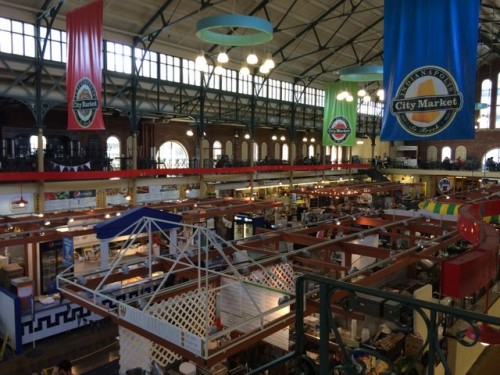
Note that I’m taking these pictures feature the market way off its peak time. And it’s busier than it was during the lunch hour back in 2009.
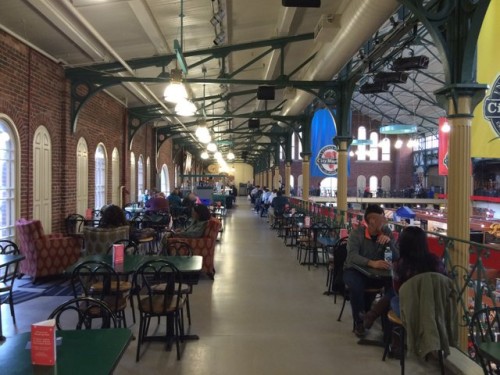
What’s the biggest factor that has influenced the Indianapolis City Market’s revival? In the last five years, the management has shrunk the overall seating space. That’s right: the market has succeeded while at the same time the space for both vendors and (particularly) for seating diminished. In 2010, the management closed the two wings, forcing the few tenants either to relocate or close. The east wing became a new YMCA/Bike Hub; the west wing became a blend of offices and shared meeting space called The Platform. The mezzanine, previously used for exorbitant amounts of seating, hosted the Tomlinson Tap Room in one corner, along with a smattering of movable kiosks.
By reducing the market’s footprint, the place became more cramped and ultimately more bustling. I revisited the market on a 2012 blog post (which also had an excerpt on Urban Indy), and the changes were monumental. Concomitant with the increase in activity, the array of vendors expanded, as did the eclecticism of the offerings. Prior to 2010, the Indianapolis City Market was a drab food court.  After the renovations, it felt, looked and smelled much more like a real market. And while it still offered a variety of prepared foods to be consumed on the spot, many vendors begun selling items cooked to order. While the produce offerings or original ingredients still seem fairly limited (produce vendors have often failed to flourish), the aggregate effect is much more in the spirit of Reading Terminal than in the past.
Now it’s time to visit the market again. But this time, I’m focusing the discussion here on Urban Indy instead of American Dirt.
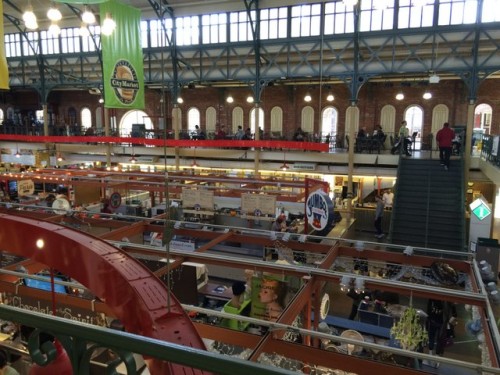
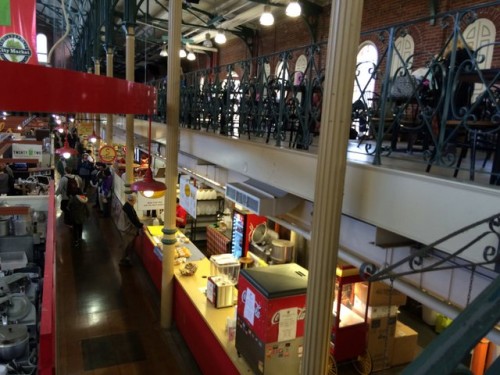
Overkill? Perhaps. But, to avoid beating a dead horse, I begin with an assertion: the City Market is continuing to succeed, but it may have less to do with the significant space modifications from 2010/11 and more with organic transformation. It helps that population density to the east of the Market has steadily increased in the last five years, and will continue to grow with new developments currently under construction. But that’s not the real meat and potatoes.
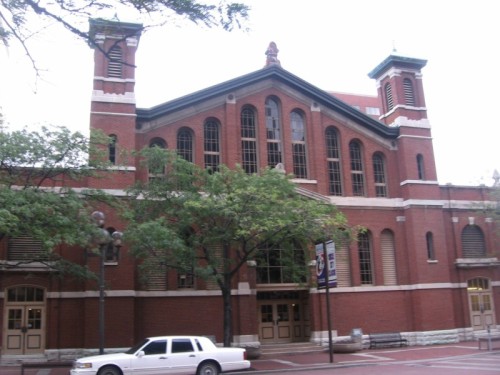
The fact is, the City Market is an old, attractive building in excellent condition, and sentimental fondness for structures such as this has skyrocketed. Whereas the nearby Circle Centre Mall was previously the go-to spot for a wide selection of quick meal options, its star has faded somewhat, replaced overwhelmingly with the locally owned establishments in the City Market. Much of this has taken place due to the escalating public interest in old buildings and our growing association of historic structures with eclectic entrepreneurship. I’m not sure if it’s simply an anti-establishment gesture—that is, we associate new construction with chains and national brands—but old buildings have become the coded method for fledgling small businesses to assert themselves. Sometimes the rent is cheaper: the old buildings are higher risk, neighborhoods offer questionable safety, and parking is inconspicuous if not outright difficult. So maybe these businesses gravitate to the older buildings simply out of frugality. But the City Market is not in a dicey area, and it’s hard to say at this point whether the rent is all that cheap. Yet, even more than in my 2012 review, most of the City Market’s leasable area is occupied, and when a tenant vacates, it doesn’t usually remain empty for long. If the vendor space is as high-demand as it seems, chances are the rents aren’t that cheap.
Rent calibration is the primary argument here. I touched upon it in the 2012 article, but now it’s more obvious than ever. My assertion from 2012 remains:
“[T]he older vendors (from before the revitalization) have some of the most generous space, while the vendors from the last year or two are comparatively cramped. . . They began their leases at a point when costs were rock-bottom because the City Market as a whole was not a terribly desirable venue. . .
Thus, the older tenants are probably paying considerably lower rates per square foot, thanks to their mature leases which, depending on how long they are, helped grandfather them in and shield them through the Market’s metamorphosis.â€
Just take a look at the floor plan for the market:
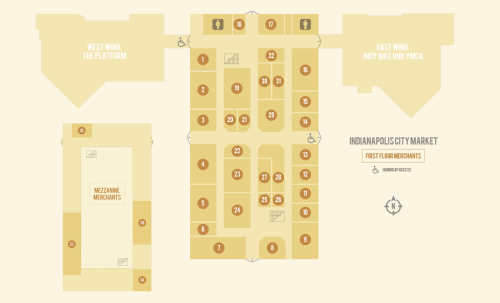
Most of the tenants are taking up relatively little real estate. But a few—like numbers 19, 23, 29, and 16—are space hogs. These tenants correspond to the following: Jumbo’s in the Market, Grecian Garden, Just Cookies, Café Olivia.What do they all have in common? They all pre-date the renovations. After the market surged in popularity, it goes without saying that the real estate became more valuable. Yet these four tenants remain, taking up as much as four times the space of the newbies. And they don’t seem to muster much consumer report. All of them—with the exception of Café Olivia—have generally negative Yelp reviews, which I hyperlinked above. While one could argue that it isn’t fair to judge them when not one of them has more than 25 reviews, it’s hard not to compare that to post-renovation businesses like 3 Carrots and 3 Days in Paris, which have amassed over 100 reviews (overwhelmingly positive) in their short life spans.
So how do places like Jumbo’s and Grecian Kitchen survive, when they take up so much more space yet ostensibly offer less quality?

The only conclusion I can draw is that they are locked into cheap lease agreements. Bully to them. And what a shame for all the other prospective tenants who could use space much more strategically and offer a competitive product. Take a look at the “kitchen†for Jumbo’s—it’s massive.
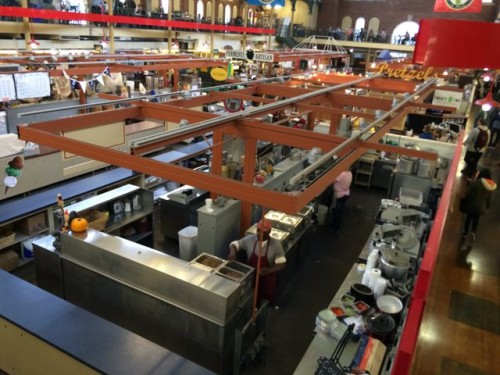
And I have good word from another newcomer tenant (and, incidentally, a regular reader of Urban Indy) that none of the food is cooked to order or prepared before the market opens. The team at Jumbo’s just pulls it from a freezer.
I’m being petty by singling out these businesses for a flogging. Unless I’m way off base, the real fault lies in management of the market, which hasn’t yet calibrated its individual leasing agreements with the demand for its real estate—at least not for those long-term tenants who are shutting out numerous other prospective vendors willing to pay the price, to offer a competitive product, and to operate in comparatively little space. The City Market is getting so much right that it’s unfair to let the perfect be the enemy of the good (a phrase I used three years ago as well). After all, management has continued to remove seating on the mezzanine to make room for more tenants, like the very new Mile Square Coffee Roastery seen below, after it had closed for the day:
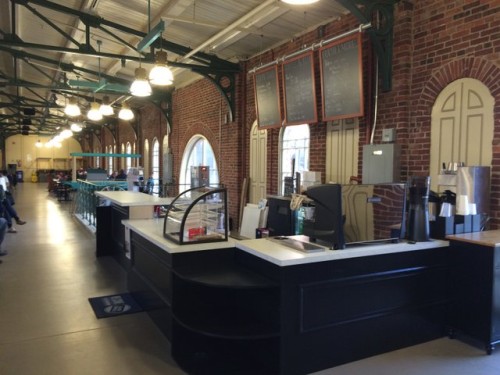
And, perhaps most significantly, the market is now open 13 hours on Saturdays. Just five years ago, the public would have laughed at the idea that the market could ever support a full day’s operation on a weekend. Many vendors refused to open; they couldn’t justify it. Now it opens only an hour later than Monday through Friday. Someday, the market might even support Sunday hours, and it might happen sooner than anyone would anticipate.
At any rate, improvement at City Market is incremental, as one would expect. For it to continue on the trajectory it has enjoyed for the last four years, here’s what I see that needs to happen:
- New leases for all tenants should equate to a space-per-square-foot basis. No exceptions for the older tenants. When the time comes for them to renew, the cost for such vast real estate should increase exponentially.
- As a result of #1, places like Jumbo’s and Grecian Garden will be forced either to downsize or close altogether, thereby making room for multiple new tenants, which in turn could bring the mix up to well over 40 vendors in the market.
- Up to 50% of the mezzanine’s floor space should go to vendors, leaving relatively little seating…which doesn’t matter because people aren’t going to the market to sit. In truly great markets, seating is always in short supply.
- The east wing’s central space and the outdoor plaza should serve as spillover space for fly-by-day tenants in kiosks or special events.
- The management should establish parameters promoting businesses that promise craftsmanship (i.e., cooking, cutting hair, preparing bouquets, repairing). This will eliminate vendors that do not ply a skill, such as the convenience store, or places that involve no actual food freshly prepared that day, such as Jumbo’s.
The capitalist in me hesitates to recommend #5, because, ideally, as the City Market becomes more desirable, it would cease to support tenants like the aforementioned. Thus, I list it as the last and lowest-priority goal, hoping that numbers 1 through 4 will be enough to kick the City Market into high gear.
With that, I finally fold my hands on this tried-and-true topic. That is, until reader suggestions prompt another article.
Good stuff, Eric. I’ll add a couple thoughts.
1) I’d say the decline of Circle Center as a food destination may have a bit too do with the food court being on the 2nd (or is it 3rd?) floor of the mall. Over the time period you mention, there has been a burst of street level food come along – both regular restaurants as well as a number of food trucks. And as a matter of fact, two Market vendors came from food (or beverage) trucks – Mile Square and Spice Box.
2) I’m torn on the seating thing, even though, as an urbanist who beats my head against the wall over dumb parking complaints in my neighborhood, I should totally know better. Lots of people eat at the Market. About half my clientele consists of people who spot me as they are grabbing a seat to eat. However, the seating could certainly be laid out more efficiently. Maybe we could invent a seating meter? With an ejector when time expires?
3) For Sundays, I could certainly see Tom Tap leading the charge for Colts game days and maybe Sunday Pacers playoff games or similar big draw Sunday events.
4) Market management has floated trying to get the city to permanently pedestrianize Market St from Alabama to Delaware. I’m personally not sure it is quite ready for that, but it is an interesting thought, especially given that Market is currently shutdown due to construction just to the east anyway. Maybe shut it down May-September?
Other than that, you are spot on that the large vendors need to be downsized. That should be the first priority.
Nice review, Eric. I’d add a bit:
There are a couple of external forces. One is that the CCB has no real food service inside; Steve Goldsmith closed the building cafeteria, probably in part to help the Market. So today the Market has long served as the de facto company cafeteria for City-County employees and visitors just a few steps from the elevators. Also, the adjacent (Gold and Brick, north of the Market) office buildings also have many City and County departments as tenants. Further, security screening for visitors is such a pain at the CCB that meetings with City staffers sometimes take place at the Market for convenience. This creates a little bit of a lunch effect.
Another external is the adjacent existence of The Platform, which is a shared office space for a number of community-development organizations. I can attest that such folks (I’m one, and work with several of the people and organizations headquartered there) tend to have a local and non-chain bias in choosing eating and catering options.
The last external is the Winter Farmer’s Market, which has been held on Saturdays on the first floor of The Platform. It’s a draw, and not only for downtown residents.
These observations seem correct and insightful. One thing, though, that I would emphasize is the connection between the revival of the City Market and the revival of interest in fresh, locally produced food.
This is evident in many of the newer vendors: Fermenti Artisan, the Tamale Place, Mile Square Coffee and Tomlinson Tap, which is owned by an association of Indiana beer producers. It is also evident in many activities that now take place at the market, including the Wednesday Farmers’ Market in Spring, Summer and Fall, and the Saturday’s Winter Farmers’ Market. And, while I do not know the details, I believe that there are offices in the common area that are concerned with strengthening the distribution of local, organic food.
In fact, one thing that worries me a bit about the future of City Market is the move of the Saturday Winter Farmers’ Market to the Circle City Industrial Complex. For me, at least, the Winter Farmers’ Market has made the City Market a very attractive destination; I often buy food there in the morning, stick around for lunch and a beer, and do other things as well. With the move of the Winter market, I will have to rethink my Saturday routine.
I agree the Farmer’s Market as an extension of the City Market helps create a robust environment can attract more people. But can anyone explain why the Original Farmers Market is held on a weekday as opposed to Saturdays?
The reason the older businesses have remained in place and continue to succeed is the clientele. People vote with their dollars. While the line to the corn fed burger restaurants clogs the walkways daily from 11:30am-1:30pm, others who source everything locally have had to reduce hours or stop serving lunch all together, or even worse end their leases and leave. CM Management would love to see a more educated food clientele come through the Market daily, but aren’t willing to promote the venue to do so.
If you want to ask real questions regarding the success (or lack thereof) of the City Market and its support of the business that serve real food, and work exclusively with local farmers, and are making real change in Indy’s food scene, ask the Board where all the “12 Chefs Of Christmas” fundraiser money has gone each year. Ask them how much they’ve paid to promote the City Market. It is promotion that will change the clientele, the foot traffic, and give businesses a chance to be open for more than just a few hours a day.
While many of us may applaud the sight of new, local, foodie oriented businesses in the Market, the reality is the average customer that supports the success of the market is buying a lunch combo with veggies from a can and a massive soda for less than $8. They want the same lunch they’ve been eating for 5-10 years, and they want it as cheap as possible.
Also, regarding opening on Sunday, most vendors won’t even open on Saturday due to lack of foot traffic. The average CM customers are employed at the adjacent offices on weekdays. The only thing bringing foot traffic on Saturdays is the IWFM, which will leave for greener, and more parking plentiful pastures at the start of 2016.
Sadly enough, it is the IWFM crowd that keeps Saturdays viable for Three Days In Paris (who, along with Brad Gate’s The Pantry is one of the mere two restaurants using locally sourced preservative free meat products). To think that there is momentum at the Market that will allow for even more hours of operation by vendors is naive.
The majority of businesses close their counters on week days at 2PM, with just a few staying open beyond that. Again, it is wholly supported by the lunch break crowd from adjacent offices.
I think you are missing some moving parts though. The reason some of the large, old Market tenants can offer $8 combo meals is because their rent is being subsidized by their newer neighbors. If their rent were current market rate, then Eric is right and they would have to downsize or close. They big question mark at this point is when or if their leases will be renegotiated.
Quoting Stevi:
“it is a fallacy that these larger, legacy-lease tenants pay less in rent. Two of the four mentioned in the article pay the highest psf rate in the Market.”
There’s always a line of 6-8 people at Grecian Garden for lunch on weekdays. They have a loyal (if older) following that does not typically bother with online reviews. That clientele appreciates seeing the same 2 friendly faces (husband and wife) every day and there’s nothing wrong with that. So don’t say that they don’t “offer a competitive product”.
Not everyone who goes to the CM wants free-range, humanely-slaughtered, GMO-free, gluten-free, grain-free, heirloom, organic, peanut-free, locally-sourced vegan balls of mush.
And thank god for that.
I like friendly faces too, and there’s not a price tag you can attach to that. And you’re right about online reviews: a platform such as Yelp skews overwhelmingly toward a yuppie demographic. But I will hold my ground that, unless Grecian Garden is paying twice or three times as much as the smaller, newer tenants, it’s getting a ridiculously sweet deal. And, as far as being the type of retailer that helps turn the City Market into a destination onto itself (which has always been the goal), Grecian Garden achieves nothing, since it’s the exact same type of meal one can get at a fast food stand, or a mall food court.
As for your criticism of “vegan balls of mush”, well, fortunately for you (and unfortunately for our nation’s waistlines), 98% of the restaurants in America offer variants of deep-fried, meat-and-potatoes comfort. If places like Jumbos and Grecian Kitchen close, you can always go somewhere down the street. LIke Circle Centre Mall, for example.
And why does everything have to be a destination? If every place is a destination, then none are. Remember that, as someone mentioned above, the CM is the de facto cafeteria for the workers at the City Council building.
And why the animosity towards what the foodie community now calls comfort food? There’s plenty of space in the CM for a variety of tastes. It’s not like people are lining up at lunchtime to visit 3 Carrots.
The people have spoken and, as such, places like the fresh vegetable stand and the seafood stand have closed, while a tenant who makes nothing but potato chips, thrives.
Sometimes there’s a reason older businesses do well. And that should be celebrated. I thought this blog understood the importance of respecting history and not just putting in something shiny and new for the sake of it.
I’m scratching my head trying to think of that place where everything is a destination. The nature of competition is that there are always winners and losers. Union Station was a destination in the late 80s and early 90s, until Circle Centre Mall opened. Then it failed in a year. Because there will always be losers in an urban environment, forums like Urban Indy will always thrive for the aspiration-minded.
This is my fifth article on the City Market. When I first wrote in 2009, the historic tenants were all that prevailed, and the facility was nothing more than a lunchtime space for workers within a block radius. At that point in time, the management at the market was seriously considering closing the entire facility altogether. The shiny new tenants may be what saves the place…the “legacy-lease tenants” as Ms. Stoesz noted, were not bringing in the foot traffic that the market enjoys now. They, too, were a few handshakes away from closure just six years ago.
I don’t think the fruit stand closed because no one shopped there. I think there was an internal beef that closed it.
You’re largely right on that count. From the words of a commentor on one of my previous City Marke blogs, Constantino’s also offered a produce selection identical o what you’d find at the Marsh three blocks away. It wasn’t competing, which put it at the same level as most of the pre-2010 CM vendors.
No one shipped there.
Actually, people do line up to visit 3 Carrots at lunchtime. I go there at least once a week (in the summer, more than once a week), and I’ve never had an occasion where there wasn’t someone in line in front of me. Sometimes it goes several persons deep. It isn’t for everyone, but the notion that buffalo seitan is mush that no one lines up for is simply, objectively false.
Not sure where this comment comes from, but the owner of the blog eats at 3 Carrots and Cafe Olivia, but not at a few of the older places mentioned here.
As someone who lives just slightly north of downtown and does not work downtown, the only time I visit the market is for the winter farmer’s market, and I’m there religiously every Saturday.
Last Saturday, the friend I usually go to the market with said, “I guess this is the last time we’ll be in the city market.”
I have been to Tomlinson Tap Room in the evening on two occasions, and although the space is kind of cool, the beer list is way cool, and the bartenders very friendly, the cavernous, empty space surrounding it is just kind of depressing.
I do like the Bike Hub’s being right there, and I have visited it (again twice), but unlike other thriving city markets, there is really not much reason for someone to visit the Indy City Market unless they happen to work nearby and need something to do on lunch hour.
Don’t forget that about 500 new residents will be moving in across the street in about a year. That will certainly bump foot traffic, but by how much, it’s hard to say.
Won’t those 500 also be accompanied by the downtown Whole Foods? I wonder how the dynamics of having a Whole Foods right there, which probably competes for a lot of customers that the newer CM tenants attract, will be. If it focuses more on groceries it might have little to no impact. If it has a deli that you can buy for lunch/dinner or a cafe, that could cause some competition. And I don’t know if CM is at a point where it can viably compete.
Good point, Matt. However, based on Whole Foods’ current financial woes, stuff at the market may be able to compete quite well. We have to acknowledge that it’s increasingly likely that, when the tower finally opens, something else might occupy that ground floor retail.
I don’t know how accurate it is, but the Whole Foods agreement has a number outs, so we’ll see if they even end up in that space. I wonder if Marsh would move old Marsh there and find some other use for that smaller space.
Love this idea.
Thanks to everyone for their comments. I was deliberately coy about the Indy Winter Farmers Market because I had heard that it was relocating, so it really won’t be a factor influencing the CM’s success much longer, particularly on Saturdays.
A few of the more cynical postings suggest that the market is basically still a non-entity after 2pm. While it’s certainly true that it loses steam, bear in mind a few places have voluntarily chosen to stay open until 6pm–one tenant expanded its hours until 9pm, as I reported back in 2012. This is a far cry from 2009, when the Market received a trickle of visitors during the lunch hour and was empty by 1pm. And remember that in 2009, management was seriously considering closing the mall altogether.
The improvement has been incremental, but if only the greaseburger tenants were successful, nothing would explain why half the tenants have taken a different approach. And a few (like 3 Days in Paris) have operated successfully since the reconfiguration. Meanwhile, many of the older, pre-transformation tenants closed. The fact that the IWFM was powerful enough to justify most vendors remaining open on Saturdays is proof that there’s a market beyond food-court style lunches.
The opening of the tower next door will provide a surge of population density, but the real effort–just as it was in 2009–must be to make the Market a destination unto itself. Way back then, I wrote about how Kansas City has a Friends of the Market 501(c)(3) organization, and that many cities offer shirts, caps, and tote bags. Indy’s CM isn’t there, and perhaps that is due to serious promotional apathy, as Jason Deetz suggests. But the market has come a long way in the last six years, considering that over half of the vendor stalls were empty or filled with placeholder displays back then.
The article and subsequent comments are greatly appreciated and certainly point out areas for opportunity within City Market. City Market management has attempted to work with its larger-scale tenants (whose long-term, legacy leases don’t expire until 2025 and were signed prior to current management’s employ) repeatedly to reduce their footprints within the Market to appropriately “right-size” them to assist in more efficient/effective operations. These merchants have refused to shrink and claim that the current space allocations are necessary to operate. In addition, it is a fallacy that these larger, legacy-lease tenants pay less in rent. Two of the four mentioned in the article pay the highest psf rate in the Market.
While management aspires to return the City Market to its agricultural and retail heritage, those leasing efforts in the past have not proven successful. Traffic counts are the highest they have been in many years, but it will take a concerted effort to retrain the consumer to think of the Market in a different way. Reaching a tipping point with the number of merchants who categorically fit this retail/agricultural model is key. Management is working with merchants to integrate those retail items into existing product lines.
Market management spends considerable time and resources on marketing, promotion, events and partnerships that garner coverage in local and national traditional and social media outlets. What was once a seven-person staff is now two and accomplishes a great deal with very little by being creative and developing smart collaborations.
Thanks to all, again, for some meaningful and thoughtful comments and criticisms.
Really appreciate your insights, Stevi. It sounds like we can continue to expect incremental improvement over time. Considering where the market was in 2009, the fact that it has gotten this far is remarkable. I guess some of the legacy-lease tenants are finding other means of cutting their costs.
Thank you, Eric. I’ll be happy to keep you apprised of the many great initiatives and programmatic efforts here at City Market. We all want the same thing for this historic gem, and we have a clear mission and direction. It may just take a bit more time to get there than we would like.
Happy Holidays to you and yours!
Thanks for commenting, Stevi. Glad to get more concrete info.
Happy to report that Cara, the owner of U-Relish, is keeping the Winter Farms Market at the City Market alive! It will be pared down a bit (about 15 vendors) and will take place on the north mezzanine (balcony) area of the main market building.
Thanks for the update. Does this mean that the Winter Farmers Market isn’t relocating to the Industrial Complex? Will it be split across two locations? Also, what are the plans for The Platform space with the departure of the WFM?
From my brief conversation with Cara, this will be in addition to the Industrial Complex market. The main driver was that there was going to be a downtime between the ending of the City Market WFM and the start of the Industrial Complex start which was going to be a pretty major hardship for some of the farmers.
It sounds like the Market continuation will be smaller and will mostly be fresh produce with no prepared stuff or artisans.
As I said, this is all secondhand info from a minute and a half conversation, so don’t take any of this as fact. Maybe I’ll see about getting some further details.
Also, no idea what will happen with the Platform space. I’m wondering if the WFM was just an “icing on the cake” income or maybe it was just breaking even due to staffing, security, utilities, or whatever other costs and doing nothing on Saturday mornings would be no marginal loss or gain.
If you’re focused on catering to the downtown lunch crowd, of course then you’re not going to be a true market that is busy ever weekend and is a viable grocery option. There are boutique, new markets like Grand Rapids’ and then there’s the oldest market in Ohio, Findlay Market in Cincinnati, that is an actual market and still does the lunch thing.
Yeah, the Indianapolis City Market is nothing more than a glorified food court.
Jumbo’s closed this week after 42 years in business. Hopefully the space gets subdivided into about 3-6 spaces.